Last Saturday, an unusually brisk spring day, an old friend and I quenched our corona-quarantine craving for the outdoors by hiking several miles of the Gunpowder South Trail, between the Masemore Hemlock area and the Prettyboy Reservoir Dam, in Baltimore County. This was a hike that he and I had taken together at least twice in the past, but not for several decades, and we found it remarkable how little this scenic stream valley had changed in all that time. On the return trip, somewhere between Falls Road and Masemore, we stopped to enjoy a small flock of migrant warblers (almost entirely males; they generally 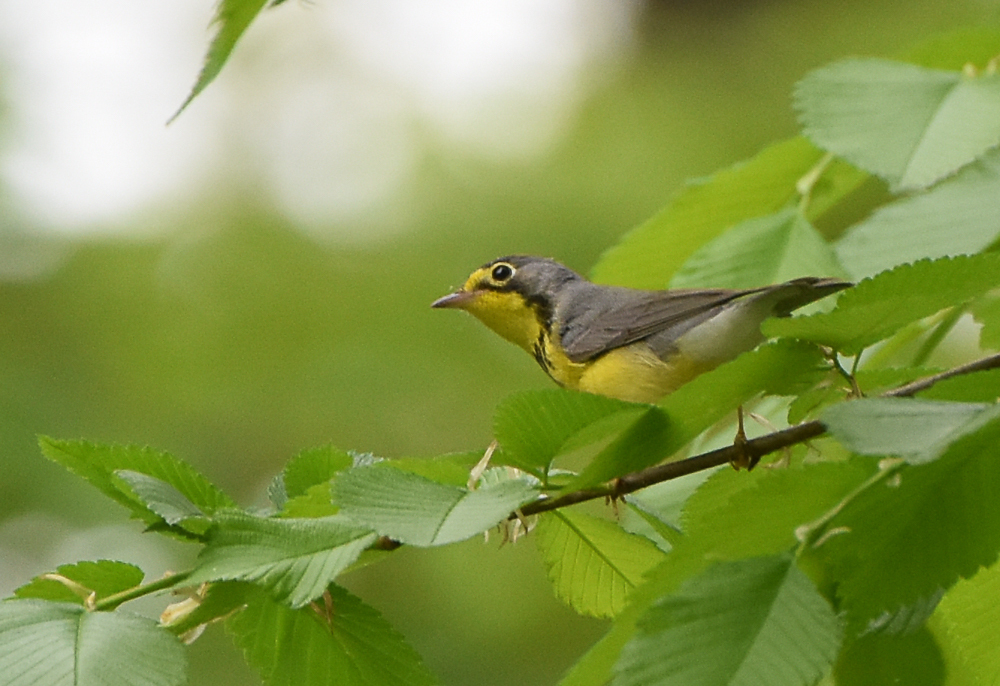 return earlier in May) on the far shore. There were five species in all, covering just about the entire color spectrum–from the finely streaked plumage of a Black-and-White Warbler to the midnight-blue (a rare hue in the bird world) of the Black-throated Blue Warbler to the lime green cap and rufous flanks of a Chestnut-sided Warbler. The real stunner was a male Canada Warbler–equal parts slate-colored back and brilliant golden breast, with a perfect little eyering, and a prominent black ‘chain’ around its neck. This gorgeous little guy only passes through the Baltimore area for a brief week or two every spring and fall on its journeys between its summer home in the forests of northern New England and the eastern Canadian provinces and its wintering grounds in Venezuela, Colombia, Ecuador, and Peru. If you’re lucky, you may find a pair breeding in boggy portions of the highlands of Garrett County (Cranesville Swamp is a nice bet), but, for the most part, Maryland is just a rest stop for this tiny traveler.
return earlier in May) on the far shore. There were five species in all, covering just about the entire color spectrum–from the finely streaked plumage of a Black-and-White Warbler to the midnight-blue (a rare hue in the bird world) of the Black-throated Blue Warbler to the lime green cap and rufous flanks of a Chestnut-sided Warbler. The real stunner was a male Canada Warbler–equal parts slate-colored back and brilliant golden breast, with a perfect little eyering, and a prominent black ‘chain’ around its neck. This gorgeous little guy only passes through the Baltimore area for a brief week or two every spring and fall on its journeys between its summer home in the forests of northern New England and the eastern Canadian provinces and its wintering grounds in Venezuela, Colombia, Ecuador, and Peru. If you’re lucky, you may find a pair breeding in boggy portions of the highlands of Garrett County (Cranesville Swamp is a nice bet), but, for the most part, Maryland is just a rest stop for this tiny traveler.
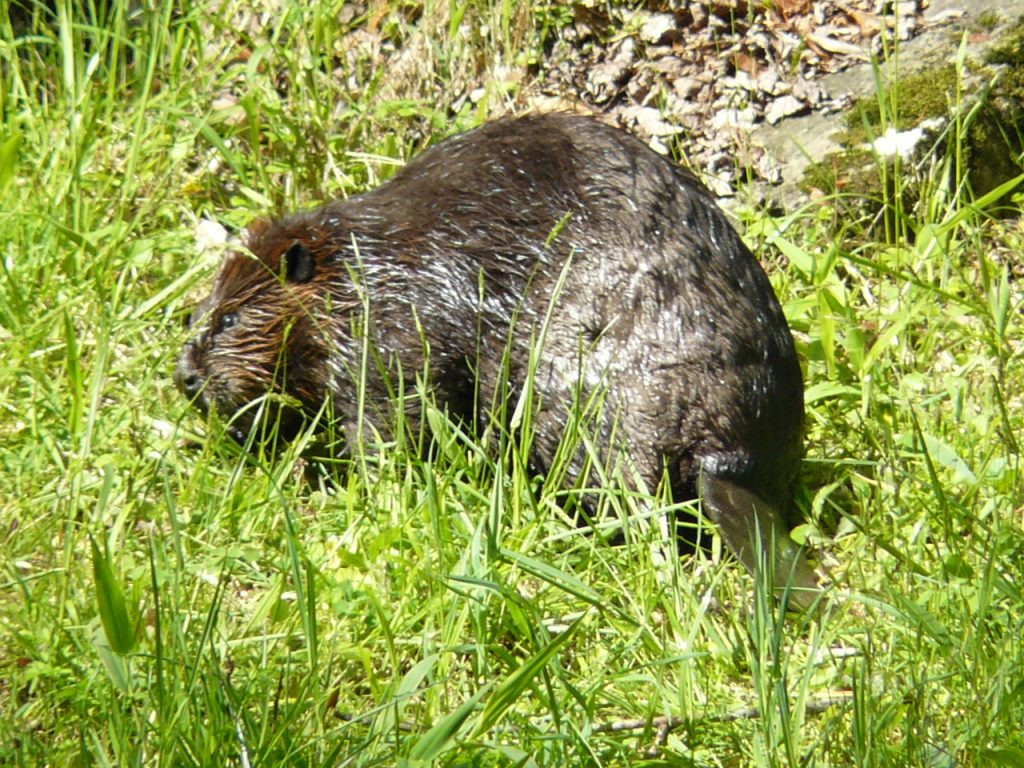 After a long stretch (it’s easy to lose track of time when a wave of spring warblers flits all around you) of appreciating how cooperatively these colorful passerines posed for us, we turned to continue downstream. At that very moment, an enormous rodent lumbered (pun intended) out of the Gunpowder and pulled itself up onto the bank directly across from us. Not only did it startle both of us, but we literally gasped at its size. This was no muskrat or even otter; it was a massive, full-grown beaver that easily weighed about 50 pounds. Both of us knew that Castor canadensis dwelled along the Gunpowder; in fact, we had each, independently, seen them before not far from here. But never had I encountered one at such close range, and neither of us had ever come across a behemoth like this one.
After a long stretch (it’s easy to lose track of time when a wave of spring warblers flits all around you) of appreciating how cooperatively these colorful passerines posed for us, we turned to continue downstream. At that very moment, an enormous rodent lumbered (pun intended) out of the Gunpowder and pulled itself up onto the bank directly across from us. Not only did it startle both of us, but we literally gasped at its size. This was no muskrat or even otter; it was a massive, full-grown beaver that easily weighed about 50 pounds. Both of us knew that Castor canadensis dwelled along the Gunpowder; in fact, we had each, independently, seen them before not far from here. But never had I encountered one at such close range, and neither of us had ever come across a behemoth like this one.
Expecting this primarily nocturnal and typically shy mammal to slip into the woods or back into the stream upon noticing us, we were surprised at how oblivious the beaver was to our presence. It found a sunny spot, roughly 25 feet from us and plopped itself down–literally sitting on its own tail–in the grass. For the next ten minutes we were entranced watching North America’s largest rodent (and one of the largest in the world) dry off after its swim, scratch, and groom its own fur, frequently reaching for its oil glands on the underside of its belly. It clearly had an agenda (beavers are supposed to be busy after all) and was NOT going to let a couple of middle-aged hikers alter its routine! Meanwhile, we barely flinched, whispering exclamations to each other about the varmint’s duck-like webbed feet, enormous hind claws (specially adapted to apply that waterproofing oil), huge flattened tail (used, like a rudder, for steering through the water, slapping the water to communicate with family members, storing fat for the winter, and temperature regulation), and teeth that certainly lived up to their ‘buck-toothed beaver’ moniker.
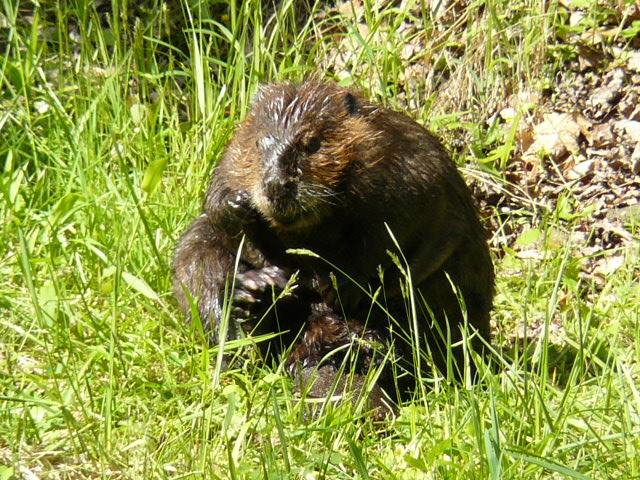
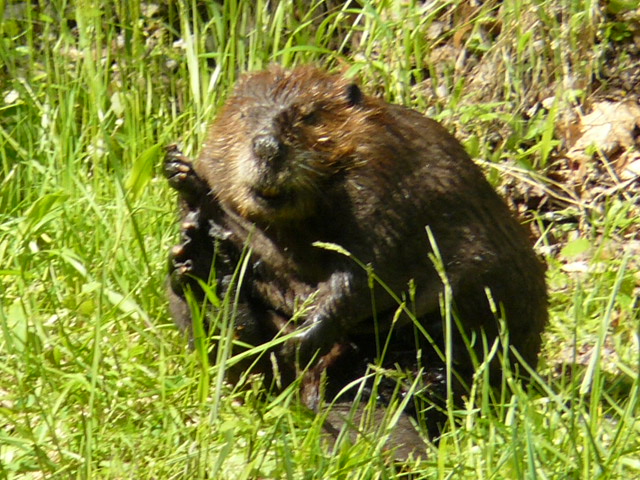
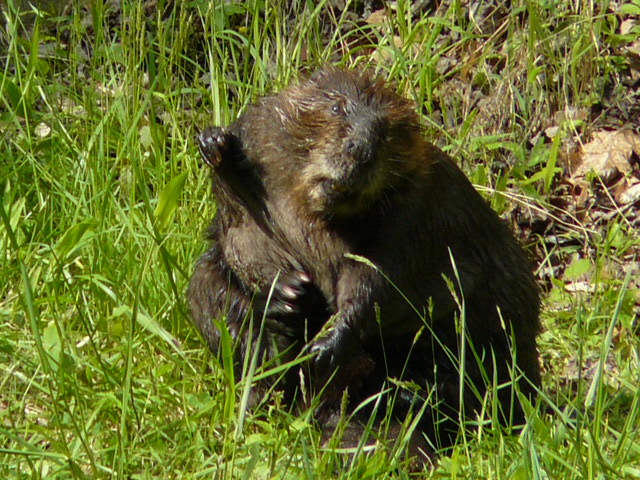
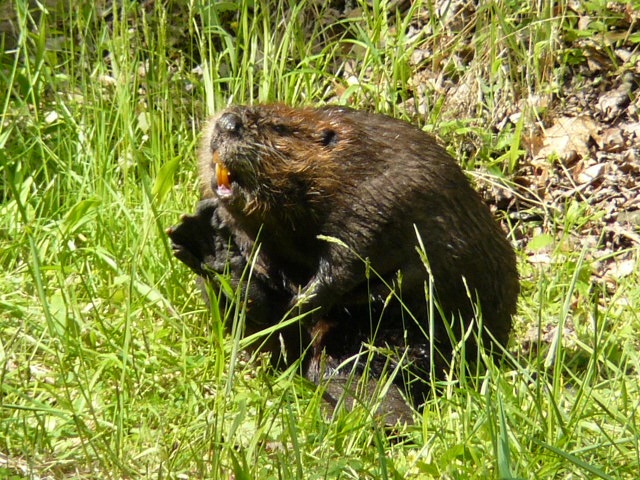
By the time Castor had finished primping, it was now late afternoon, the winds were picking up, and the sun disappeared behind some increasingly ominous-looking cloud cover. Surely now it would move on to other business! Wrong again. The critter, finally pleased that its lush coat of fur was squeaky clean and fully presentable, turned slightly, faced us head-on, and . . . sat there. And sat. And sat some more. It was literally as wide as tall and, like an enormous bowling ball, would’ve done a perfect forward roll into the water had someone just nudged it from behind. In fact, it reminded me very much of an overstuffed teddy bear.
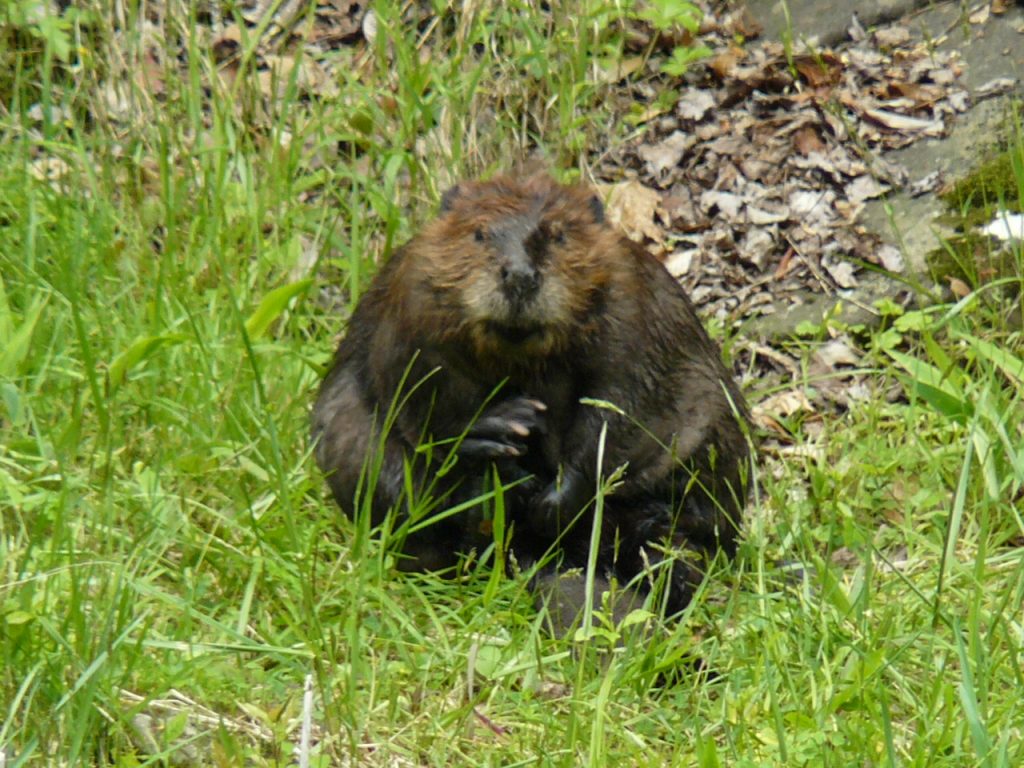 In the end, Mr./Ms. Beaver had more patience than we. We were cold and a wee bit nervous about possibly getting rained upon, and headed back to our car, vastly enriched by this unexpected (as all good wildlife encounters should be) half-hour meeting with Castor canadensis. I’ve been thinking about that experience a great deal over the past six days, so much so that I’ve been surprised how much it impacted me. Wondering why it made a bigger impression than most ‘cool wildlife sightings,’ I’ve been doing a little reading that has helped clarify a few things. You see . . .
In the end, Mr./Ms. Beaver had more patience than we. We were cold and a wee bit nervous about possibly getting rained upon, and headed back to our car, vastly enriched by this unexpected (as all good wildlife encounters should be) half-hour meeting with Castor canadensis. I’ve been thinking about that experience a great deal over the past six days, so much so that I’ve been surprised how much it impacted me. Wondering why it made a bigger impression than most ‘cool wildlife sightings,’ I’ve been doing a little reading that has helped clarify a few things. You see . . .
- Whereas the American Beaver was once one of the most numerous North American mammals (scientists estimate that the precolonial population may have reached 400 million!), its thick lush pelt was also the primary driver of the fur trade in colonial times. Intense trapping began already in the 1600’s, but accelerated in the late 1700’s and early 1800’s, when felt hats became the style in Europe. By the late 1800’s, beavers were almost completely extirpated from the eastern U.S. and even western populations were in serious trouble. The last native beaver in Pennsylvania (my home state) was trapped near the northern headwaters of the Susquehanna River in 1912; Maryland’s had all been gone for decades by then.
- Fortunately, reintroduction efforts began in our area in the 1950’s (earlier in PA), and, interestingly enough, the very first place in which the Maryland DNR
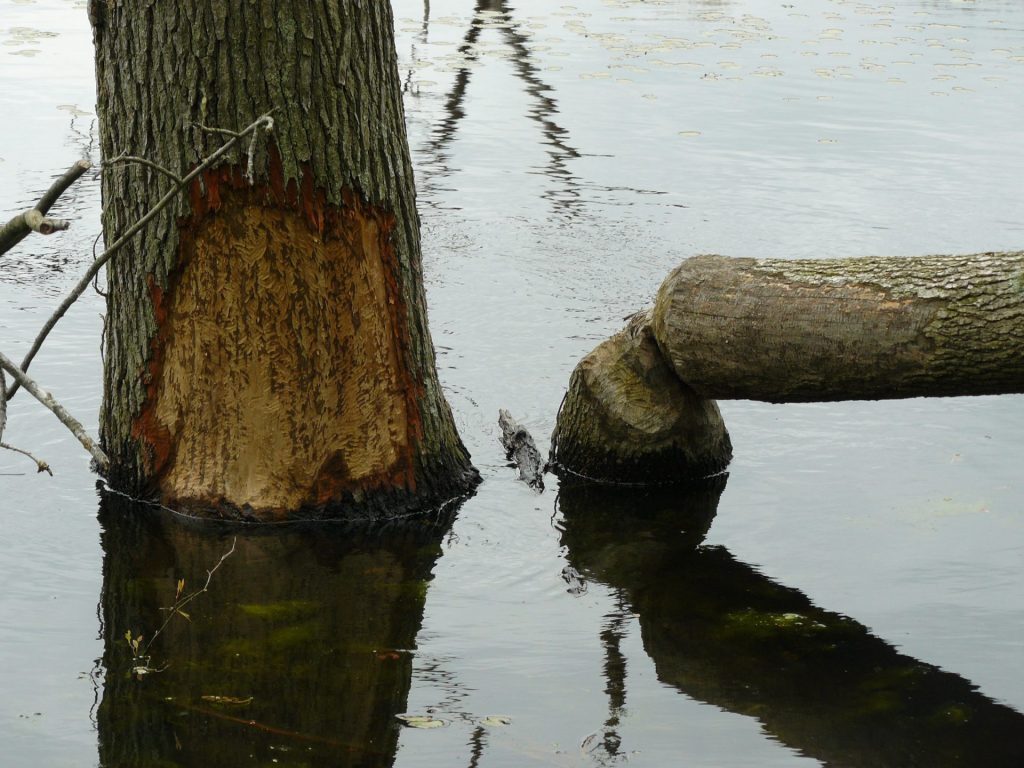 released beavers that had been transported from other parts of the country was in the Gunpowder Falls! However, it took several decades of additional releases and gradual dispersal for Castor canadensis to reside throughout the region once again. This is likely why our recent chance meeting made such an impression on me. I’m one of the last of the Baby Boomers, grew up in the 1970’s, and really started spending the bulk of my free time outdoors in the 1980’s. By that point, beavers were still not widely established in the Mid-Atlantic, although numbers were slowly growing. As a teenager, I recall seeing ten or twenty muskrats for every beaver I came across. They were a rare encounter, and, like most people, I saw more evidence (chewed off stumps, lodges, and dams) than actual animals. Heck, I’d encounter more introduced Nutria on my birding outings than native beavers. (Note: it’s taken time, but our beaver population has rebounded nicely; somewhere between 10 and 15 million currently live in the U.S. and Canada.)
released beavers that had been transported from other parts of the country was in the Gunpowder Falls! However, it took several decades of additional releases and gradual dispersal for Castor canadensis to reside throughout the region once again. This is likely why our recent chance meeting made such an impression on me. I’m one of the last of the Baby Boomers, grew up in the 1970’s, and really started spending the bulk of my free time outdoors in the 1980’s. By that point, beavers were still not widely established in the Mid-Atlantic, although numbers were slowly growing. As a teenager, I recall seeing ten or twenty muskrats for every beaver I came across. They were a rare encounter, and, like most people, I saw more evidence (chewed off stumps, lodges, and dams) than actual animals. Heck, I’d encounter more introduced Nutria on my birding outings than native beavers. (Note: it’s taken time, but our beaver population has rebounded nicely; somewhere between 10 and 15 million currently live in the U.S. and Canada.)
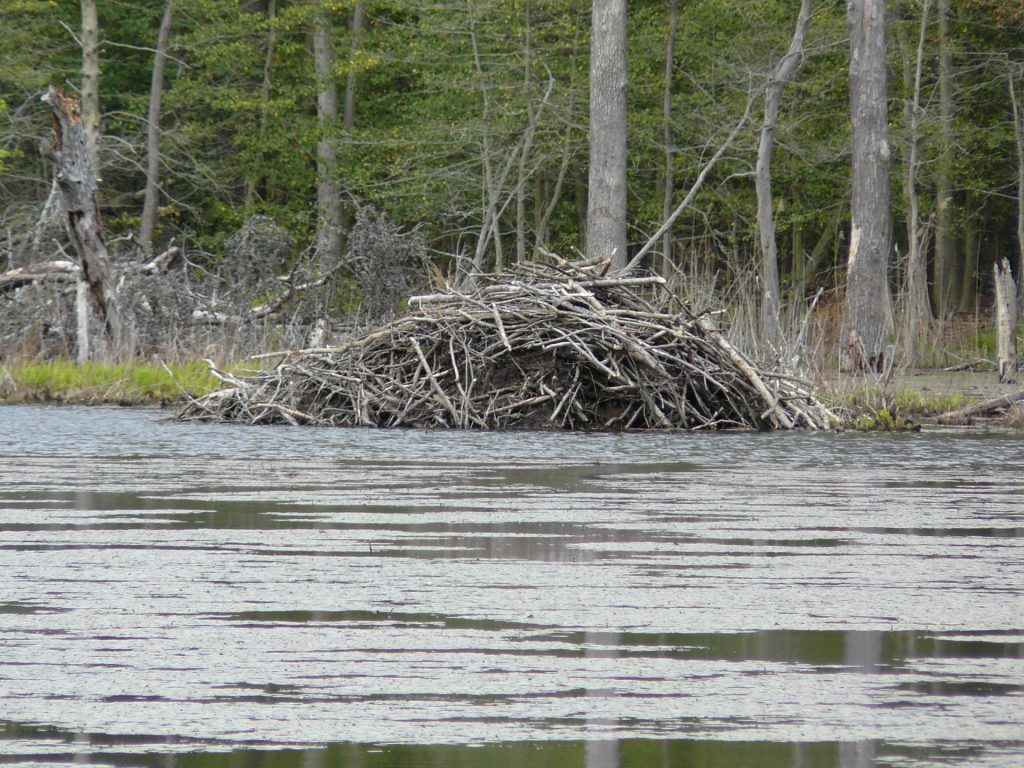
- I suspect some of my fascination with Castor also comes from my thirty years of teaching math. Beavers are the ultimate architects of the animal world and spend most of their waking hours chewing, transporting, and assembling logs into truly impressive structures. When one sees a beaver lodge (like this one at North Point State Park →) it is not unlike an iceberg; fully half of it is below the water line. However, there is an elaborate sleeping chamber within, large enough to hold 8-10 individuals through the winter; the outer sticks have been coated with a layer of mud ‘insulation’; there’s generally a smaller submerged mound nearby to provide an extra food cache; and the sleeping chamber is even constructed so as to have ventilation holes. It’s no wonder that thirteen American colleges use the beaver as their mascot, including M.I.T. and Cal. Tech! Those rodents are brainy!
- It is precisely these architectural talents that make the American Beaver an animal that most ecologists both love and hate at the same time. Beaver dams are built to flood areas and create deeper ponds where water would normally flow by quickly. There is actually an impressive example directly below the new boardwalk of the Dell Family Pathway ↓ on the Owings Mills campus of Stevenson University. Two small sections of the Gwynns Falls flow
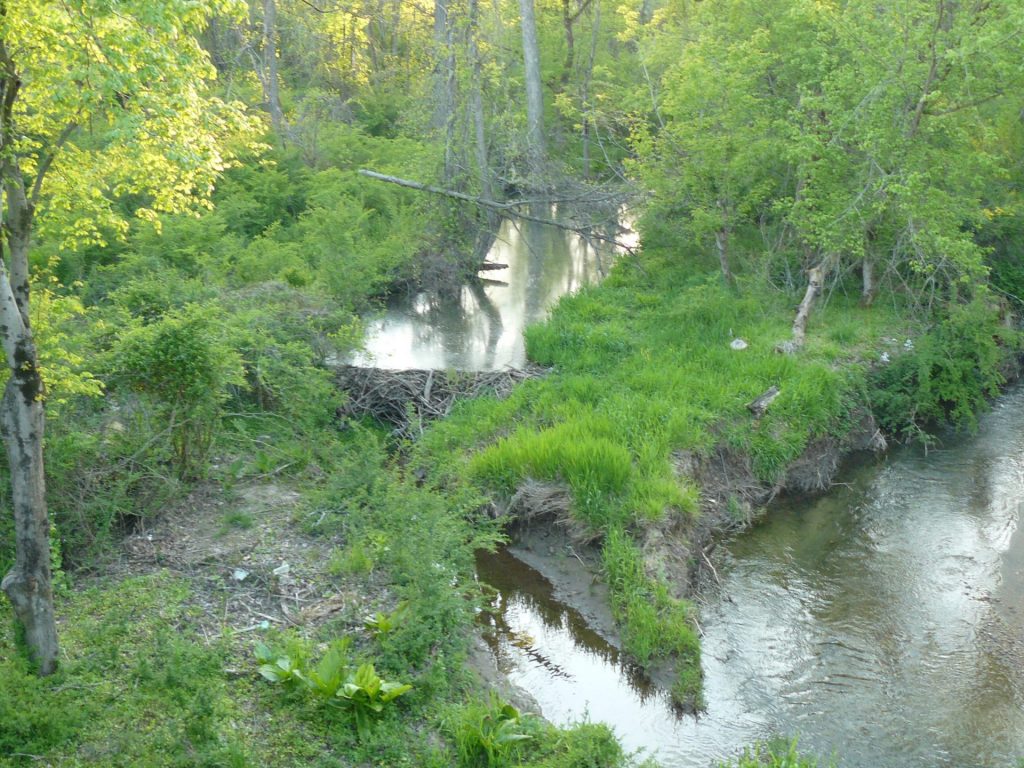 under that boardwalk; one moves quickly and is only inches deep, the other has been dammed up by beavers and is stagnant and much deeper. The ponds created by beaver dams create wonderful habitat for many wildlife species; the flooding eventually kills overstory trees, creating snags for woodpeckers, herons, wood ducks, and osprey. Pond edges grow lush with willows and aspens, creating ideal habitat for minks, muskrats, waterfowl, and fish. Where there are beavers, there will undoubtedly be lots of other great aquatic biodiversity nearby. However, . . . back to the Gunpowder: the steady flow downstream from the Prettyboy dam is ideal for trout–perhaps the best stream in the state. Fishermen flock to the cold, clear Gunpowder, in search of native Brookies and also introduced Brown and Rainbow Trout. Trout are a cold-water fish, and that requirement doesn’t mesh well with the lifestyle of beavers. The trees that beavers fell create gaps in the canopy, allowing sunlight to warm the water, and the pooling that results from beaver dams slows the stream current to a trickle at best, allowing the water to warm further. Just like any natural system, there is a give-and-take tension between how one organism’s habits affect another’s needs. That’s why we need wildlife biologists, whose job it is to strike the balance and maintain populations at levels at which they can coexist. After all, there’s nothing better than a streamside afternoon with a beaver after a morning spent trout-fishing! –BR
under that boardwalk; one moves quickly and is only inches deep, the other has been dammed up by beavers and is stagnant and much deeper. The ponds created by beaver dams create wonderful habitat for many wildlife species; the flooding eventually kills overstory trees, creating snags for woodpeckers, herons, wood ducks, and osprey. Pond edges grow lush with willows and aspens, creating ideal habitat for minks, muskrats, waterfowl, and fish. Where there are beavers, there will undoubtedly be lots of other great aquatic biodiversity nearby. However, . . . back to the Gunpowder: the steady flow downstream from the Prettyboy dam is ideal for trout–perhaps the best stream in the state. Fishermen flock to the cold, clear Gunpowder, in search of native Brookies and also introduced Brown and Rainbow Trout. Trout are a cold-water fish, and that requirement doesn’t mesh well with the lifestyle of beavers. The trees that beavers fell create gaps in the canopy, allowing sunlight to warm the water, and the pooling that results from beaver dams slows the stream current to a trickle at best, allowing the water to warm further. Just like any natural system, there is a give-and-take tension between how one organism’s habits affect another’s needs. That’s why we need wildlife biologists, whose job it is to strike the balance and maintain populations at levels at which they can coexist. After all, there’s nothing better than a streamside afternoon with a beaver after a morning spent trout-fishing! –BR
Photo Credit: Canada Warbler photographed by Emily Stanley, May 15, 2020 (just this morning!)
All other photos taken myself, most of them on May 9, 2020.
If, like Ward and June Cleaver, you’re worried about the beaver, get more great info. here; for a more scholarly summary, try this.
